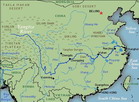2020 Yangtze River Cruise and Ferry Starting from 79 USD p.p.!
Qutang Gorge
Video A![]()
Video B![]()
Video C![]()
Immediately below Baidi City is
Kui Men, the entrance to the first of the three
gorges of the 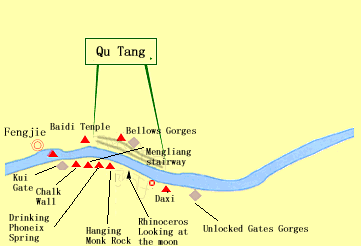 Yangtze
River-the eight--kilometre (five-mile) long
Qutang Gorge (also known by early Western travellers
as the Wind Box Gorge). The shortest but grandest
of them all, the gorge's widest point is only
150 metres (500 feet). Mists frequently swirl
around the mysterious Iimestone peaks, some
nearly 1,200 metres (4,000 feet) high, and the
river rushes swift as an arrow through the narrow
entrance, pounding the perpendicular cliff faces
on either side of the gorge.
Yangtze
River-the eight--kilometre (five-mile) long
Qutang Gorge (also known by early Western travellers
as the Wind Box Gorge). The shortest but grandest
of them all, the gorge's widest point is only
150 metres (500 feet). Mists frequently swirl
around the mysterious Iimestone peaks, some
nearly 1,200 metres (4,000 feet) high, and the
river rushes swift as an arrow through the narrow
entrance, pounding the perpendicular cliff faces
on either side of the gorge.
This gorge was a particularly dangerous
stretch during high-water seasons and has been
known to rise to 50 metres (165 feet). An upper
Yangtze steamboat captain recalled how in September
l929 the level of water was 75 metres (246 feet),
and likened the passage to a trough, with the
water banked up on both sides. His ship became
quite unmanageable, and was carried down, broadside
on, only coming under control again at the lower
end. He would never, he vowed, try to negotiate
it again at such a level.
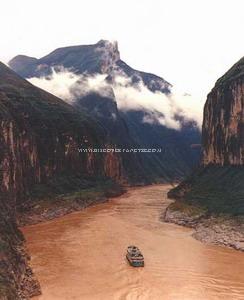 Two
mountains--Red Passage Mountain (Chijia Shan)
to the north, once compared to a celestial peach,
and White Salt Mountain (Baiyan Shan) to the
south form the Kui Men entrance, their steep
precipices like the wings of a giant door guarding
the tumultuous waters.
Two
mountains--Red Passage Mountain (Chijia Shan)
to the north, once compared to a celestial peach,
and White Salt Mountain (Baiyan Shan) to the
south form the Kui Men entrance, their steep
precipices like the wings of a giant door guarding
the tumultuous waters.
In the Tang dynasty (618--907) chains
were strung across the river as an 'iron lock'
to prevent passage of enemy boats. ln the Song
dynasty (960--l279) two iron pillars nearly
two metres (six feet) tall were erected on the
north side, and seven chains, some 250 metres
(820 feet) long, were used to block the river
passage. Although the original purpose was defensive,
the chain locks were later used to enable local
authorities to gather taxes from all boats travelling
downriver. This system continued until the middle
Qing dynasty (1644--1911). The iron pillars
are only visible at low water.
On the precipice of Bai Yan Shan
(south side) are a series of holes nearly a
metre (three feet) apart and about one-third
of a metre (one foot) deep, forming a 'Z' shape.
These are known as the Meng Liang Stairway.
According to legend, YangJiye, a Song-dynasty
general, was buried on a terrace high up on
the mountain. His loyal comrade--in-arms, Meng
Liang, decided secretly to take the bones back
for burial in Yang's home town. In the dead
of night he took a small boat into the gorge
and began to hack out a pathway to the terrace.
Halfway up the rock face he was discovered by
a monk who began crowing like a cock. Meng Liang,
thinking that dawn was reaking and fearing discovery,
abandoned his task. When he later discovered
the monk's mischief, he was so provoked that
he hung the monk upside down over a precipice.
The rock below Meng Liang Stairway is known
as Hanging Monk Rock (Daodiao Heshangshi). History
records, however, that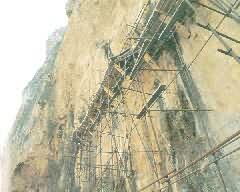 General Yang was not buried here and the steps
are probably the remains of an ancient river
pathway. Sections of a city wall, 1,400 years
old, have been found on top of Bai Yan Shan
so it is possible that the pathway led to this
early settlement. Another theory about the stairway
suggests that it was built to provide access
to the rare medicinal herbs which grow high
on the cliff faces.
General Yang was not buried here and the steps
are probably the remains of an ancient river
pathway. Sections of a city wall, 1,400 years
old, have been found on top of Bai Yan Shan
so it is possible that the pathway led to this
early settlement. Another theory about the stairway
suggests that it was built to provide access
to the rare medicinal herbs which grow high
on the cliff faces.
At the highest point above Hanging
Monk Rock one can see Armour Cave (Kuanaiia
Dong) where it is said a Song-dynasty woman
general hid her weapons. In 1958 the cave was
explored and found to contain three 2,000-year-old
wooden coffins from the Kingdom of Ba, in which
were bronze swords and lacquered wooden combs.
Near the Meng Liang Stairway is
the Drinking Phocnix Spring, a stalagmite in
the shape of a phoenix drinking the sweet spring--water.
Nearby is the Chalk Wall (Fengbi Tang) where
900 characters, dating from the Song dynasty,
have been carved by famous calligraphers on
the rock face. The site derives its name from
the limestone powder which was used to smooth
rock surfaces before being carved.
On the north side of the river,
opposite Meng Liang Stairway, is a coffee-coloured
precipice called 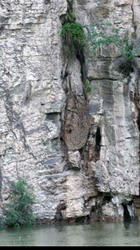 Bellows
Gorge Fengxiang Xia). The name refers to some
square configurations in the rock face, which
were supposed to be bellows used by Lu Ban,
the god of carpenters. In 1971 the secret of
Bellows Gorge was revealed, when ancient suspended
wooden coffins, similar to those found in the
Armour Cave, were discovered in the caves of
the precipice. Some of these have been moved
to museums, but three remain and can be seen
from the river.
Bellows
Gorge Fengxiang Xia). The name refers to some
square configurations in the rock face, which
were supposed to be bellows used by Lu Ban,
the god of carpenters. In 1971 the secret of
Bellows Gorge was revealed, when ancient suspended
wooden coffins, similar to those found in the
Armour Cave, were discovered in the caves of
the precipice. Some of these have been moved
to museums, but three remain and can be seen
from the river.
Wise Grandmother's Spring (Shenglao
Quan) in a rock crevice on the southern bank
was, according to legend, created by an immortal
grandmother from heaven for thirsty travellers.
They had only to call out to the spring 'Worthy
Grandmother, a drink!' and water would gush
for a moment from the rock.
East of Armour Cave (on the south
side), on the top of a black rock, is a huge
stone which the Chinese say resembles the body
of a rhinoceros looking westwards as if forever
enjoying 'the autumn moon over the gorge gate'.
They call this rock Rhinoceros Looking at the
Moon.
From Baidi Cheng to Daixi through
the whole length of Qutang Gorge, visitors may
see, high up on the northern face, the old towpath,
hand-hewn in 1889 by the local people. Prior
to this there existed a smaller towpath which
was often submerged at high water. Remnants
of this path can still be seen below Bellows
Gorge. Travellers had to abandon their boats
and climb over the peaks, a dangerous and time-wasting
detour. Boats going upstream had to wait for
a favourable east wind, if the wind was in the
wrong quarter, boats could be stranded in the
water for ten days or more.
The sandstone walls of the gorges
have become pitted by natural erosion, causing
lines of holes, some of which are several metres
deep. The town of Daixi, at the mouth of a stream
bearing the same name, marks the eastern end
of Qutang Gorge. Over 200 burial sites have
been found here, and excavations have revealed
a rich collection of bone, stone and jade artifacts
and pottery, as well as various burial forms
of the middle and late New Stone Age period.
Below Daixi the river widens out.
About five kilometres (three miles) downstream,on
the south bank, are two sharp, black peaks Which
form the Unlocked Gates Gorge (Suokai Xia).
On the west side of the gorge, midway up the
mountain, is a semi- circular stone shaped roughly
like a drum-this is the Beheading Dragon Platform
(Zhanglong Tai). Facing this on the opposite
side of the gorge is a thick, round stone pillar,
the Binding Dragon Pillar (Suolong Zhu). Once
upon a time, the Jade Dragon, a son of the Dragon
of the Eastern Sea, lived in a cave on the upper
reaches of the DaixiStream. One season he decided
to visit his family by way of the Yangtze, but
shortly afterwards found himself lost Changing
into the form of an old man, he asked his way
of a herds boy. The boy pointed north with his
sickle. The dragon rushed off in that direction
but again got lost, whereupon he flew into a
mighty rage and rushed at the mountains, causing
them to crumble and dam up the river; farmlands
were flooded, earthquakes toppled houses, and
men and animals perished. At this moment the
Goddess Yao Ji rushed to the spot on a cloud.
She rebuked Jade Dragon, but he was unrepentant.
She flung a string of pearls into the air, it
changed into a rope that bound the dragon to
the stone pillar. Yao Ji then ordered the great
Da Yu,controller of rivers, to behead the murderous
dragon on the nearby platform. He then diverted
the river by cutting the gorge. The people of
this valley have lived happily ever since.
Two kilometres (1.2 miles) further,
the Baozi Tan (a triple rapid) and the XiamaTan
used to be serious dangers to shipping at low-water
level. A traveller on one of the Yangtze steamships
in the 1930s remarked : Only the throbbing of
the engines as the bow entered the most turbulent
part of the rapid, and buried its nose deep
in the boiling water, revealed its presence
to the uninitiated. But on looking back one
could see that there had been a drop of two
or three feet in the water where the rapid was
most violent. Above it was a series of whirlpools
and races.

